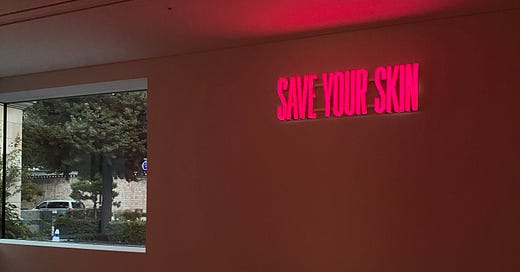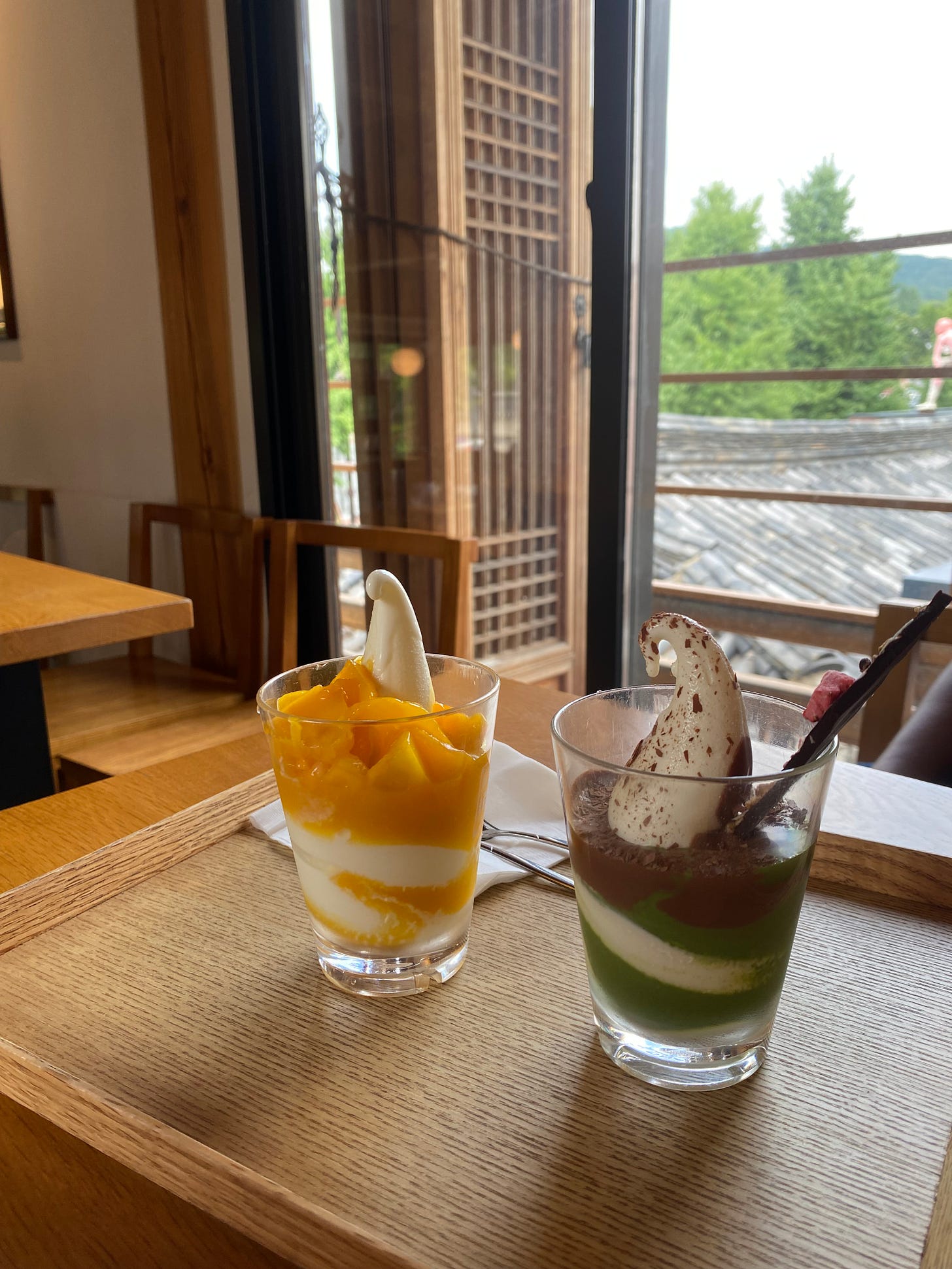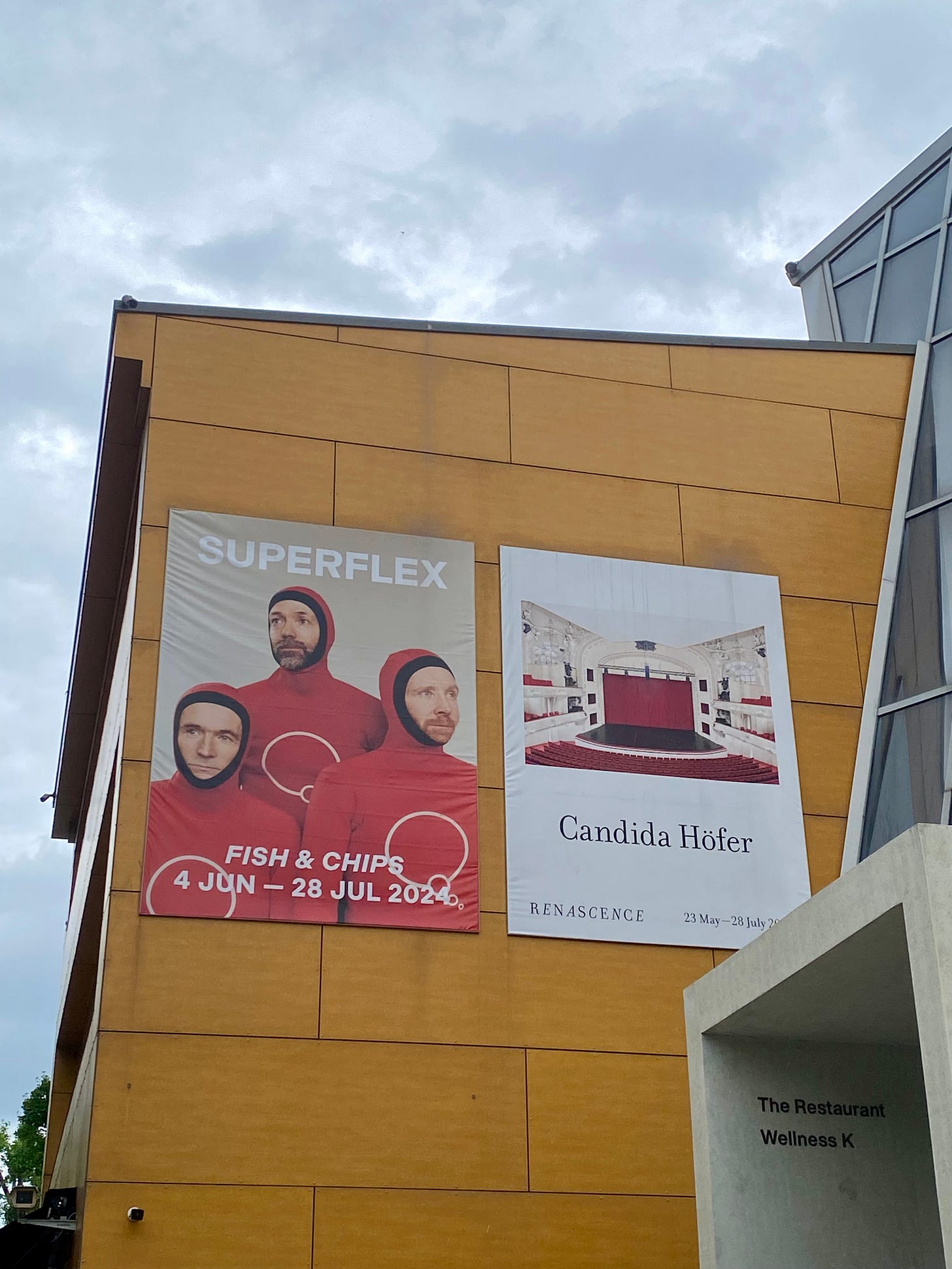How do you get ready to go to an art exhibit?
Do you have a pre-show ritual?
Do you down an iced coffee?
Do you make sure that your purse (aka MoMA tote bag) is just the right amount of artfully full?
Do you dress up? Dress down? Neither?
Are you already brainstorming the shots you’ll need for IG?
Do you get yourself in the mindset to view art?
There are a million different answers to that question. After all, viewing art is just as much a performance as it is genuine. Why not commit to the bit?
But what all of these answers fail to recognize is the simple most important, life-changing potential part of a pre-exhibition routine:
✨Ice cream✨
A friend and I met up last weekend to catch up and do two things:
See Fish & Chips
Eat ice cream
Ok, so, hear me out: Seoul is disgusting right now. Until you’ve spent typhoon season in East & Southeast Asia—aka the entirety of July and into August—you don’t know the meaning of uncomfortable. As I type this I’m reading the forecast for Thursday and the prediction says: 40°C, thunderstorms, 85% humidity. No thanks.
Anyway, it was a solid plan for a day out if I do say so myself. We met at Baekmidang (백미당), which is housed in a modern hanok sandwiched between the National Museum of Modern & Contemporary Art and Hakgojae Gallery. It boasts ice cream made from, “premium, organic sources,” but really it’s the perfect opportunity to treat oneself. I went for soft-serve with chunks of apple mango, and my friend opted for soft-serve with matcha and dark chocolate.
✨D e c a d e n t✨
After cooling off we walked just a minute down the block to Kukje Gallery (국제갤러리). For those of you unfamiliar with Korean galleries as a whole, Kukje Gallery is one of Korea’s premier domestically-founded 'blue-chip' galleries.
What is a 'blue chip' gallery, you might ask? The term 'blue chip' refers to a tier (a category? A class?) of galleries that mainly sell high-value artworks made by artists with solid reputations whose works will often only increase in value over time. To make it simple, it’s how one might differentiate between an experimental, new space for up-and-coming artists versus a gallery representing artists like Picasso or Anish Kapoor. If you want to go back in time, the term ‘blue chip’ was coined on the stock market by Oliver Gingold in the 1920s to refer to a “reputable and profitable business.”1
So, ‘blue chip.’ Kukje was founded in 1982 and moved to its current location in 19872, now spanning 3 gallery spaces in historic Samcheong-dong (삼청동). If you keep up with South Korea’s economic history, you’ll know that it was founded in the middle of the country’s unrivaled economic boom, the famous, “Miracle on the Han River,” that brought the country out of post-war destitution and into a new age of financial freedom and international influence. Their roster is impressive: Alexander Calder, Roni Horn, Ugo Rondinone, Park Seo-Bo, and Lee Ufan amongst others.
Other domestically-founded galleries of the same echelon include:
Gallery Hyundai is just down the street from Kukje. Founded in 1970, they represent artists such as Lee Tschang-yeul, Ik-joong Kang, and Park Hyun-ki.
PKM Gallery in the opposite direction near the Blue House, representing the likes of Olafur Eliasson, Yun Hyong-keun, Dan Flavin, and Cody Choi.
Leeahn Gallery’s Seoul branch. Originally founded in the southern city of Daegu, a city at the center of some of the country’s most prized private collections, they represent the likes of Kiki Smith, Nam June Paik, Damien Hirst, and Andy Warhol.
Something that makes Seoul so compelling in terms of art is that it’s invested in new artists. Your average gallery will be showcasing lesser-known, young, often boundary-pushing artists that keep you on your toes. To me, that’s so exciting! The scene as it is today is never boring and hasn’t truly subscribed to a level of almost…monotony that one might find at times in cities like New York and London. So, I try to balance out my visits to the “big players,” with probably double the amount of smaller galleries. I’m lucky to live near spaces like P21, Whistle, Foundry Seoul, workingwithfriend, POST, and more. But those are for future posts.
So…Kukje.
I‘ll be the first to admit that I rarely enter an exhibit with an artist’s full CV already lodged in my brain, even for artists I know well. SUPERFLEX is one of the many whose works have stood out to me but, unfortunately, I haven’t delved into very deeply. In fact, I don’t think that before this show I’d seen any of their works in person. But after hearing rave reviews of their 2023 commission by the Real DMZ Project, in addition to their recent works at the 2024 Venice Biennale, I knew that a trip out would be worth it.
According to the exhibition text of Fish & Chips, SUPERFLEX, “…scrutinize[s] and expose[s] hidden systems of power by engaging with themes such as unbalanced economic conditions as well as issues of migration, copyright, and ownership.”3 As an entity, they do something that I love, which is to trick the viewer. Well, maybe not trick, per se, but challenge the viewer to say, ‘Hey, wait a minute, am I seeing what I think I’m seeing?’
The work entitled Investment Bank Flowerpots is a great example of what I’m trying to say. When you walk into the far gallery at the back of Kukje’s K1 building, you end up in a room of white: white walls, white paintings, and one white ceramic vase. The vase is an unusual shape, all angular and rectangular with doorways and stairs leading to nowhere at its base. Inside is a singular plant, which at the time I didn’t know the name of. All I knew was that the shape, its placement, all of it was something I liked. Flash forward to reading the exhibition text and the piece is described as:
Modeled on the architecture of the headquarters of [the] global investment banks, including Goldman Sachs, Deutsche Bank, Citigroup, and JPMorgan Chase, the flowerpots function as pots for growing hallucinogenic plants. Each work hosts a different type of plant—Peyote, San Pedro cacti, and marijuana—whose euphoric effects allegorize the toxic qualities of monetary transactions.
However, when I read this I was curious about how the curator had handled the installation of this work. Why? For lack of a more eloquent explanation: drugs are very, very illegal in South Korea. But if one reads further, it is explained that the vase represents Citigroup (which does operate in Korea) and planted within the vase is Nerium Oldeander, a poisonous plant native to Jeju Island off Korea’s southern coast.4
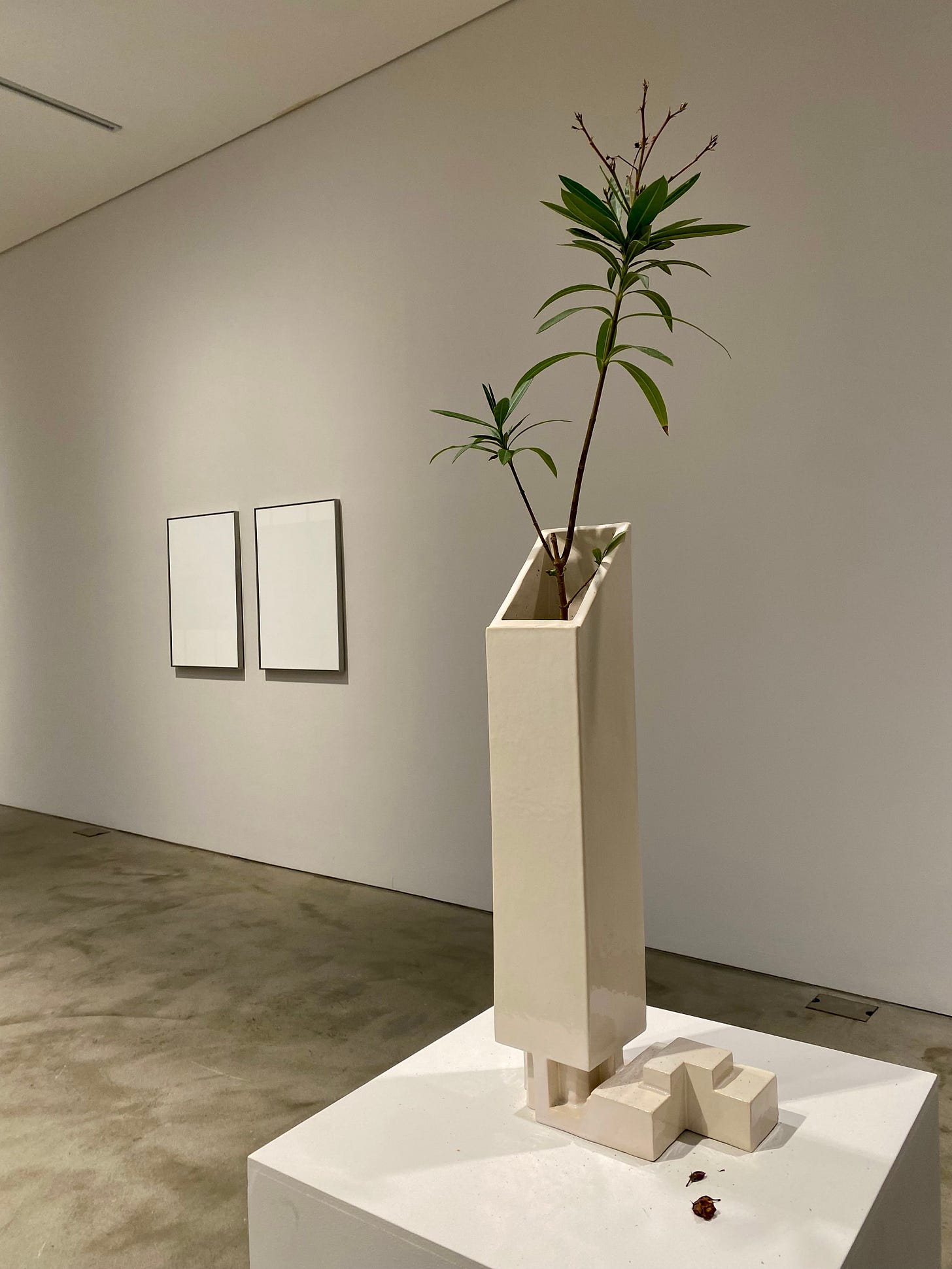
In a country whose society has as-of-late been labeled with words such as, “materialistic,” “vain,” and “image-obsessed,” it’s interesting to see this work juxtaposed with an ongoing complex conversation. This work made me think of my generation’s global struggles with debt, stagnant wages and a bleak economic outlook for our future. It’s a struggle faced globally, Korea being no exception. If one talks about ‘euphoria’ in regards to spending, I can’t help but think of Seoul as a case study in the prioritization of short-term happiness; a happiness exploited by banks over and over again until the debt is inescapable.
And how can one not go the extra mile for short-term joy when the future is almost certainly doomed? How can you cheat yourself out of a latte when it's statistically impossible to own a house in your lifetime?
Now, I know what at least some of you are thinking: Emma, how can artists who are being paid thousands of dollars for artworks displayed in renowned galleries have real input on economic inequality? Isn’t it hypocritical?
And, well, you’re not wrong. It’s a constant conundrum when you tackle the art history canon as a whole, let alone contemporary art on its own. There’s no denying that we’re living through unprecedented, impossibly overwhelming states of economic inequality right now. I’ve had weeks where I don’t want to go anywhere near a gallery because it seems like their mere existence mocks the rest of us; sometimes I read sales reports from Art Basel or Frieze and laugh because how can an industry that’s selling artworks for that much really claim that it’s struggling?
But multiple things can be true at once, and artists can tackle a wide range of social issues while admitting their privilege within said system. We live in a reality where some of the most iconic artworks of our time were commissioned by some of the worst people to walk the earth; the makeup of some pigments is lost to time because we forced the materials into extinction due to overuse. Some artists are more genuine than others and more believable; others, not so much. However, SUPERFLEX to me lands in the former category.
Walking from piece to piece, it was clear that the selection of materials was itself an artwork separate from the final piece; the meticulous consideration of each element itself contributes as much to the future identity of the artists involved as the work created. For instance, the sculptures in the K3 building entitled As Close As We Get are constructed from basalt, lioz coral and steel. The sculptures, “…imagine underwater infrastructure that accommodates the needs of both fish and humans in an era beyond the Anthropocene.”5 Even in the arrangement of the materials, a unique intention is to be found: “…[the sculptures] reflect the geometry of the K3 building which, according to the artists, ‘looks like a giant fishing net that has caught different geometrical shapes.’”6
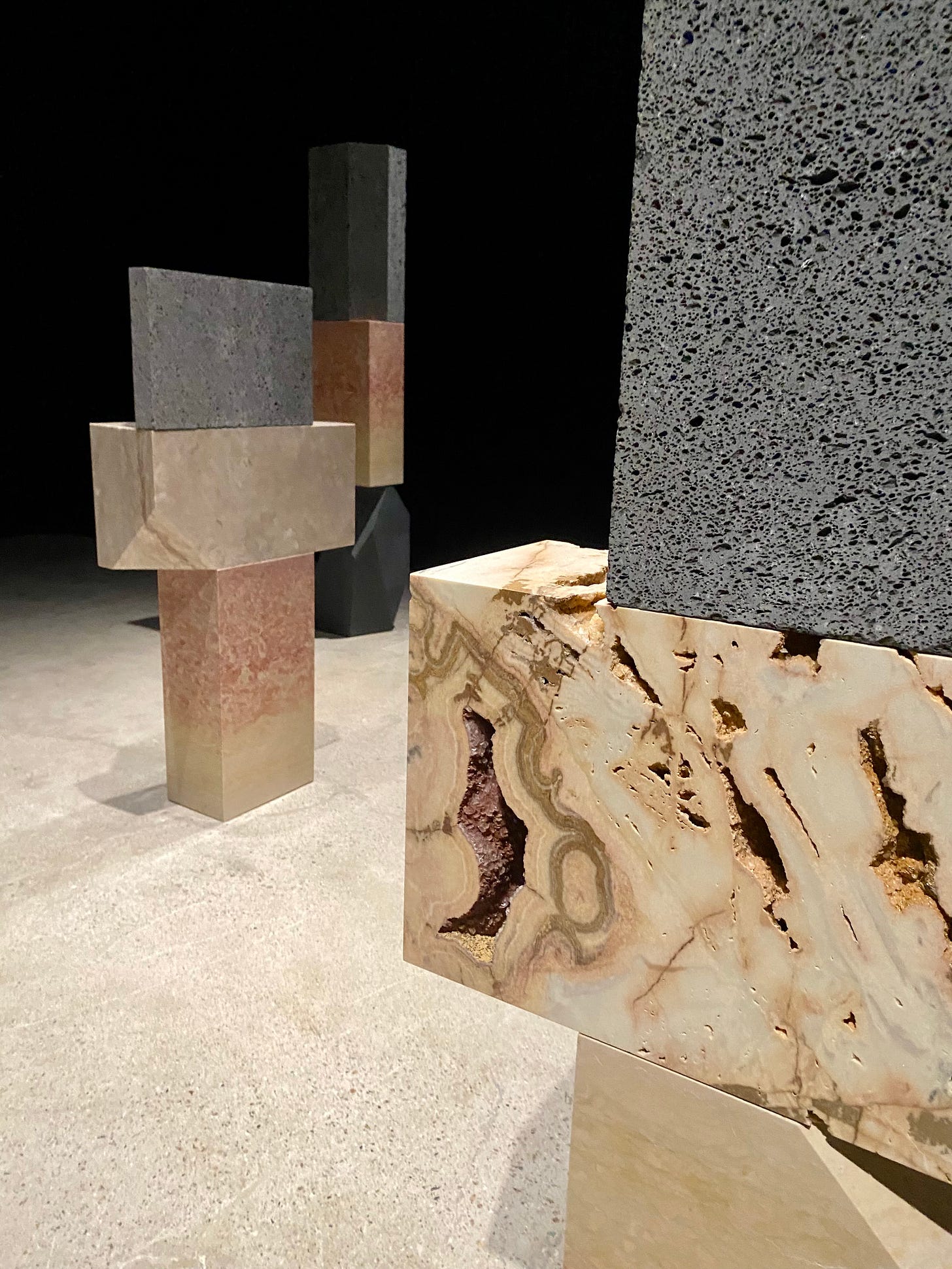
The sculptures share a space with an interactive animation entitled Vertical Migration. Originally commissioned by ART 2030 and TBA21-Academy, it was projected onto the UN Secretariat Building during the 76th UN General Assembly.7 Depicting a, “…computer-generated siphonophore, a jellyfish-like underwater life form that bears no resemblance to human beings.”8 The animation confronts a shared fate between marine organisms and humans that is only partially visible but whose gravity weighs on all of us. Is there beauty to be found in how evolution may “save” us through adapting to a world broken by our own hands? Will it truly be broken if this new version of both humans and organisms manages to survive? Does it matter, considering how close we are to the point of no return anyway?
It’s not that deep unless, well, maybe it is.
SUPERFLEX may be asking the big questions themselves, but the viewer can easily see the irony of it all: the push and pull between a sculpture made to criticize corrupt financial systems and those who make it possible artworks to be bought in the first place. Walking away from this exhibit, you’re left with a reminder that artworks and artistic practice alike cannot exist independently of the larger societal systems that they contribute to, or even criticize. Critique cannot and will not exist in a bubble; if anything, we all exist in a gray area.
There’s just enough to be angry about, just enough amidst that to keep us afloat till the next hurdle comes.
(And hopefully enough sweet treats, too.)
What is blue-chip art?. Grove Gallery. (2023, October 10). https://grovegallery.com/what-is-blue-chip-art/
Kukje Gallery. KUKJE GALLERY. (n.d.). https://www.kukjegallery.com/about/seoul_gallery
Exhibition text, Fish & Chips, SUPERFLEX, Kukje Gallery, Seoul, ROK
Exhibition text, Fish & Chips, SUPERFLEX, Kukje Gallery, Seoul, ROK
Exhibition text, Fish & Chips, SUPERFLEX, Kukje Gallery, Seoul, ROK
Exhibition text, Fish & Chips, SUPERFLEX, Kukje Gallery, Seoul, ROK
Exhibition text, Fish & Chips, SUPERFLEX, Kukje Gallery, Seoul, ROK
Exhibition text, Fish & Chips, SUPERFLEX, Kukje Gallery, Seoul, ROK

